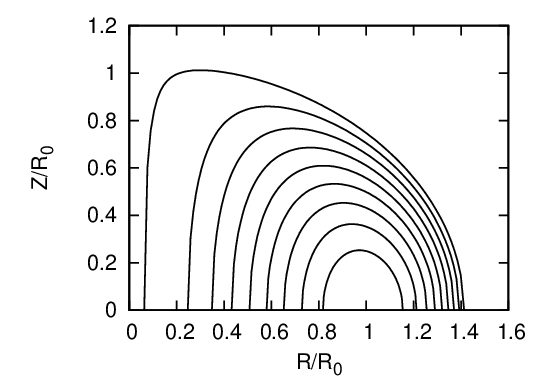
For most choices of P(Ψ) and g(Ψ), the GS equation (66) has to be solved numerically. For the particular choice of P and g profiles given by
 | (511) |
 | (512) |
analytical solution to the GS equation can be found, which is given by[16]
 | (513) |
where c0, c1, c2, and R0 are arbitrary constants. [Proof: By direct substitution, we can verify Ψ of this form is indeed a solution to the GS equation (66).] A useful choice for tokamak application is to set c0 = B0∕(R02κ0q0), c1 = B0(κ02 + 1)∕(R02κ0q0), and c2 = 0. Then Eq. (513) is written
![[ ]
---B0-- 2 2 κ20 2 22
Ψ = 2R20κ0q0 R Z + 4 (R − R 0) ,](tokamak_equilibrium655x.png) | (514) |
which can be solved analytically to give the explicit form of the contour of Ψ on (R,Z) plane:
 | (515) |
which indicates the magnetic surfaces are up-down symmetrical. Using Eq. (511), i.e.,
 | (516) |
the pressure is written
 | (517) |
where P0 is a constant of integration. Note Eq. (514) indicates that that Ψ = 0 at the magnetic axis (R = R0,Z = 0). Therefore, Eq. (517) indicates that P0 is the pressure at the magnetic axis. The toroidal field function g is a constant in this case, which implies there is no poloidal current in this equilibrium. (For the Solovev equilibrium (514), I found numerically that the value of the safety factor at the magnetic axis (R = R0,Z = 0) is equal to q0g∕(R0B0). This result should be able to be proved analytically. I will do this later. In calculating the safety factor, we also need the expression of |∇Ψ|, which is given analytically by
![∘ (---)----(---)--
∂-Ψ 2 ∂-Ψ 2
|∇Ψ | = ∂R + ∂Z
B ∘ -------------------------------
= ---20-- [2RZ2 + κ20(R2 − R20)R ]2 + (2R2Z )2. (518)
2R 0κ0q0](tokamak_equilibrium659x.png)
Define Ψ0 = B0R02, and Ψ = Ψ∕Ψ0, then Eq. (514) is written as
where R = R∕R0, Z = Z∕R0. From Eq. (519), we obtain
 | (520) |
Given the value of κ0, q0, for each value of Ψ, we can plot a magnetic surface on (R,Z) plane. An example of the nested magnetic surfaces is shown in Fig. 38.

The minor radius of a magnetic surface of the Solovev equilibrium can be calculated by using Eq. (515), which gives
 | (521) |
 | (522) |
and thus
 | (523) |
where A = 8R02q0∕(B0κ0). In my code of constructing Solovev magnetic surface, the value of a is specified by users, and then Eq. (523) is solved numerically to obtain the value of Ψ of the flux surface. Note that the case Ψ = 0 corresponds to Rin = Rout = R0, i.e., the magnetic axis, while the case Ψ = R02B0κ0∕(8q0) corresponds to Rin = 0. Therefore, the reasonable value of Ψ of a magnetic surface should be in the range 0 ≤ Ψ < R02B0κ0∕(8q0). This range is used as the interval bracketing a root in the bisection root finder.
Using Eq. (523), the inverse aspect ratio of a magnetic surface labeled by Ψ can be approximated as[16]
 | (524) |
Therefore, the value of Ψ of a magnetic surface with the inverse aspect ratio 𝜀 is approximately given by
 | (525) |